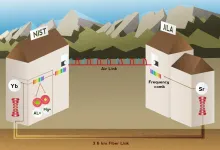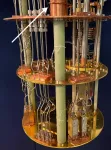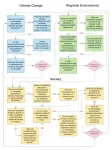(Press-News.org) In a significant advance toward the future redefinition of the international unit of time, the second, a research team led by the National Institute of Standards and Technology (NIST) has compared three of the world's leading atomic clocks with record accuracy over both air and optical fiber links.
Described in the March 25 issue of Nature, the NIST-led work is the first to compare three clocks, based on different atoms, and the first to link the most advanced atomic clocks in different locations over the air. These atomic clock comparisons place the scientific community one step closer to meeting the guidelines for redefinition of the second.
"These comparisons are really defining the state of the art for both fiber-based and free-space measurements--they are all close to 10 times more accurate than any clock comparisons using different atoms performed so far," NIST physicist David Hume said.
The new measurements were challenging because the three types of atoms involved "tick" at vastly different frequencies, because all the many network components had to operate with extreme accuracy, and because the wireless link required cutting-edge laser technology and design.
The study compared the aluminum-ion clock and ytterbium lattice clock, located in different laboratories at NIST Boulder, with the strontium lattice clock located 1.5 kilometers away at JILA, a joint institute of NIST and the University of Colorado Boulder. The team's measurements were so accurate that uncertainties were only 6 to 8 parts in 1018--that is, errors never exceeded 0.000000000000000008--for both fiber and wireless links.
NIST researchers previously described how they transferred time signals over the air link between two of the clocks, the NIST ytterbium and JILA strontium clocks, and found the process worked as well as the fiber-based method and 1,000 times more precisely than conventional wireless transfer schemes. This work shows how the best atomic clocks might be synchronized across remote sites on Earth and, as time signals are transferred over longer distances, even between spacecraft.
The key to the air link was the use of optical frequency combs, which enable accurate comparisons of widely different frequencies. NIST researchers developed two-way transfer methods to precisely compare optical clocks over the air, even in conditions of atmospheric turbulence and laboratory vibrations. The comb-based signal transfer technique had been demonstrated previously but the latest work was the first to compare state-of-the-art atomic clocks.
Since 1967, the second has been defined based on the cesium atom, which ticks at a microwave frequency. The atomic clocks used in the new comparisons tick at much higher optical frequencies, which divide time into smaller units and thus offer greater precision. Comparisons are crucial to the international community's selection of one or more atoms as the next time standard.
The new NIST results reported in Nature also set other important records. Frequency is the most accurately measured single quantity in science. The NIST team measured frequency ratios, the quantitative relationships between the frequencies of the atoms as measured in three pairs (ytterbium-strontium, ytterbium-aluminum, aluminum-strontium). The results are the three most accurate measurements ever made of natural constants. Frequency ratios are considered constants and are used in some international standards and tests of fundamental physics theories.
Frequency ratios offer an important advantage as a metric for evaluating optical atomic clocks. A direct measurement of an optical clock frequency in the usual units of Hertz is limited by the accuracy of the current international standard, the cesium microwave clock. Frequency ratios overcome this limitation because they are not expressed in any units.
Frequency ratios are usually measured over long distances by use of fiber networks, which are few and far between, or in some cases with microwave data transferred over satellite links, which tend to be unstable.
Guidelines for redefinition of the second recommend the demonstration and verification of multiple frequency ratio measurements with uncertainties approaching the best optical clock performance. All three types of clocks in the new study offer superlative performance now and promise further improvements. NIST's ytterbium clocks, for example, represent the natural frequency of the atoms (a value known as systematic uncertainty) to within a possible error of just 1.4 parts in 1018--about one billionth of a billionth.
NIST's new frequency ratio measurements, while record-setting, are not quite that good yet. But the research team is working on improving measurement stability and clock performance, Hume said.
Beyond their role in the next generation of international standards, optical atomic clocks can be used as sensitive probes for new physics, such as the "dark matter" believed to constitute most of the stuff in the universe. Technological applications for optical clocks include improved timing and navigation systems and measuring Earth's gravitational shape (geodesy).
INFORMATION:
This work was supported in part by the Defense Advanced Research Projects Agency, Air Force Office of Scientific Research, National Science Foundation, Office of Naval Research, NASA Fundamental Physics, and Department of Energy.
Paper: Boulder Area Clock Optical Network (BACON) Collaboration, K. Beloy, M.I. Bodine, T. Bothwell, S. Brewer, S.L. Bromley, J.-S. Chen, J.-D. Deschenes, S. Diddams, R. Fasano, T.M. Fortier, D. Hume, D. Kedar, C.J. Kennedy, I. Khader, A. Koepke, D.R. Leibrandt, H. Leopardi, A. Ludlow, W. McGrew, W. Milner, N. R. Newbury, D. Nicolodi, E. Oelker, T.E. Parker, J.M. Robinson, S. Romisch, J. Sherman, L.C. Sinclair, L. Sonderhouse, W.C. Swann, J. Yao, J. Ye, and X. Zhang. Frequency Ratio Measurements with 18-Digit Accuracy Using an Optical Clock Network. Nature. March 25 issue, posted online March 24.
Carbon dioxide in the atmosphere fuels plant growth. As carbon levels rise, it's appealing to think of supercharged plant growth and massive tree-planting campaigns drawing down the CO2 produced by fossil fuel burning, agriculture and other human activities.
New research published March 24 in Nature, however, suggests that when elevated carbon dioxide levels drive increased plant growth, it takes a surprisingly steep toll on another big carbon sink: the soil.
One likely explanation, the authors say, is that plants effectively mine the soil for nutrients they need to keep up with carbon-fueled growth. Extracting the extra nutrients requires revving up microbial activity, which then releases CO2 into the atmosphere that might otherwise remain locked in soil.
The findings contradict ...
The secret to building superconducting quantum computers with massive processing power may be an ordinary telecommunications technology - optical fiber.
Physicists at the National Institute of Standards and Technology (NIST) have measured and controlled a superconducting quantum bit (qubit) using light-conducting fiber instead of metal electrical wires, paving the way to packing a million qubits into a quantum computer rather than just a few thousand. The demonstration is described in the March 25 issue of Nature.
Superconducting circuits are a leading technology for making quantum computers because they are reliable and easily mass produced. But these circuits must operate at cryogenic temperatures, and schemes for wiring them to room-temperature electronics are complex and prone to ...
As the signs of today's human-caused climate change become ever more alarming, research into the ways past societies responded to natural climate changes is growing increasingly urgent. Scholars have often argued that climatic changes plunge communities into crisis and provide the conditions that lead societies to collapse, but a growing body of research shows that the impacts of climate change on past populations are rarely so straightforward.
In a new paper published in Nature, scholars in archaeology, geography, history and paleoclimatology present a framework for research into what they term 'the History of Climate and Society' (HCS). The framework uses a series of ...
LEBANON, NH - Some melanoma patients respond very well to immunotherapy, experiencing profound and durable tumor regression. A fraction of these patients will also develop autoimmunity against their normal melanocytes--the cells that give rise to melanoma--a phenomenon called vitiligo. Melanoma survivors with vitiligo have long been recognized as a special group with an outstanding prognosis, and a strong response of immune system cells called T cells.
Immunotherapy researchers at Dartmouth's and Dartmouth-Hitchcock's Norris Cotton Cancer Center (NCCC) led by Mary Jo Turk, PhD, and surgical oncologist Christina Angeles, MD (now of University of Michigan), have discovered how a subset ...
The ocean is dynamic in nature, playing a crucial role as a planetary thermostat that buffer global warming. However, in response to climate change, the ocean has generally become stabler over the past 50 years. Six times stabler, in fact, than previously estimated--as shown by a new study that researchers from the CNRS, Sorbonne University, and IFREMER have conducted within the scope of an international collaboration.* Warming waters, melting glaciers, and disrupted precipitation patterns have created an ocean surface layer cut off from the depths. Just as oil and ...
Training babies' brains and bodies might delay the onset of Rett syndrome, a devastating neurological disorder that affects about 1 in 10,000 girls worldwide.
In experiments with mice that replicate the genetic disorder, scientists discovered that intense behavioral training before symptoms develop staves off both memory loss and motor control decline. Compared to untrained mice, those trained early in life were up to five times better at performing tasks that tested their coordination or their ability to learn, Howard Hughes Medical Institute Investigator Huda Zoghbi and her colleagues report March 24, 2021, in the journal Nature.
Those data, from animals whose symptoms closely mimic the human disease, offers a clear rationale for genetically screening newborns for Rett syndrome, ...
New York, NY (March 24, 2021) -- Immunotherapy is not only significantly less effective in liver cancer patients who previously had a liver disease called non-alcoholic steatohepatitis (NASH), but actually appears to fuel tumor growth, according to a Mount Sinai study published in Nature in March. NASH affects as many as 40 million people worldwide and is associated with obesity and diabetes.
The researchers led a large international collaboration to investigate immunotherapy's effect on hepatocellular carcinoma (HCC), a deadly liver cancer, caused by NASH. They conducted a meta-analysis ...
New scientific findings bring hope that early training during the presymptomatic phase could help individuals with Rett syndrome, a neurodevelopmental disorder, retain specific motor and memory skills and delay the onset of the condition. Researchers at Baylor College of Medicine and the Jan and Dan Duncan Neurological Research Institute at Texas Children's Hospital reported in the journal Nature that, in a mouse model of Rett syndrome, intensive training beginning before symptoms appear dramatically improved the performance of specific motor and memory tasks and substantially delayed the appearance of symptoms.
The researchers propose that newborn genetic testing for Rett syndrome, followed by prompt intensive training in the skills that will be affected, such ...
Immunotherapy using checkpoint inhibitors is effective in around a quarter of patients with liver cancer. However, to date, physicians have been unable to predict which patients would benefit from this type of treatment and which would not. Researchers from the German Cancer Research Center have now discovered that liver cancer caused by chronic inflammatory fatty liver disease does not respond to this treatment. On the contrary: in an experimental model, this type of immunotherapy actually promoted the development of liver cancer, as now reported in the journal Nature.
Liver cancer is the sixth most common type of cancer in the world, ...
The heart of any computer, its central processing unit, is built using semiconductor technology, which is capable of putting billions of transistors onto a single chip. Now, researchers from the group of Menno Veldhorst at QuTech, a collaboration between TU Delft and TNO, have shown that this technology can be used to build a two-dimensional array of qubits to function as a quantum processor. Their work, a crucial milestone for scalable quantum technology, was published today in Nature.
Quantum computers have the potential to solve problems that are impossible to address with classical computers. Whereas current ...



